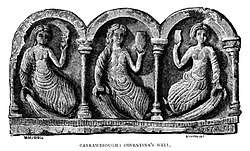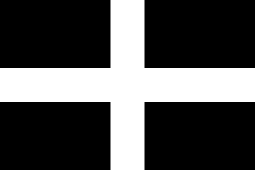Pseudoarchaeology of Cornwall
The pseudoarchaeology of Cornwall concerns aspects of the study of Cornwall that fall outside mainstream archaeology, history, and cultural studies. Pseudoarchaeological approaches differ from the mainstream disciplines in methodology, which often leads to very different ideas. Mainstream scholars generally do not consider the methodologies used in pseudoarcheology to be valid, since they do not follow the scientific method.
| Part of a series on |
| Celtic mythology |
|---|
 |
| Gaelic mythology |
| Brythonic mythology |
| Concepts |
| Religious vocations |
| Festivals |
|
Pseudohistorical myths associated with Cornwall, notably the Arthurian tradition and the Brutus myth form an important part of cultural history and have had great influence.
The density and antiquity of archaeological sites in Cornwall has attracted many, including people associated with the New Age, and neo-pagan movements.
Pseudoarchaeology and ideas like it may go by other names including "alternative archaeology" and Earth mysteries.
Pseudohistory of Cornwall
There is a Cornish legend of the lost land of Lyonesse, which was lost to the sea in the past. The exact location of Lyonesse is in doubt. It is claimed to represent the folk memory of the flooding of the Isles of Scilly and Mount's Bay near Penzance.[1] For example, the Cornish name of St Michael's Mount is Karrek Loos y'n Koos, literally, "the grey rock in the wood". The Breton legend of Ys is a similar concept.
Links with the ancient Middle East are also involved in pseudohistorical claims related to Cornwall and the wider Celtic Britain, including speculation concerning the identity of the Picts. Some have associated the Cornish piskies of folklore with the Picts.[2] The identity and origins of the Picts have attracted various speculations, including a Middle Eastern Semitic, or pharaonic Egyptian origin to the Pictish language.[3] Most mainstream scholars believe the Pictish language to have been P-Celtic (i.e. an Indo-European language of the Celtic branch), and there is no real evidence that legends of piskies are related to the historical Picts.
There is evidence that there was long-distance trade in tin or copper from Cornwall in Bronze and Iron Age times.[4] Some speculate that some Iron Age buyers in Cornwall were Phoenician or Carthaginian. Timothy Champion found it likely that the trade of the Phoenicians with Britain was indirect and under the control of the Veneti of Brittany.[5]
There is also a legendary tradition concerning a visit by the biblical Joseph of Arimathea to Cornwall, which in some forms, makes the claim that the boy Jesus accompanied him.[6][7]
The Cornish language is also a topic that has attracted pseudohistorical interpretations and folk etymologies, notably the origin of the Cornish word kyttrin, meaning in English, bus (motorbus) (in the context of public transport)[8] Folk etymology has also been associated with surnames derived from the Cornish language. The Cornish language is however of mainstream linguistic, historic, and cultural interest.
John Boson writes in 1710 (transliterated into a revived Cornish orthography):
- Gomar mab Jafet mab Noy a veu an kensa den a wrug clappya Kernowak i’n termyn a veu Tour Babel derevys – which translates as: "Gomer son of Japhet son of Noah was the first man to talk Cornish at the time when the Tower of Babel was built"[9]
There is a variety of traditional Cornish folklore which includes stories concerning giants, piskies and other folkloric beings. The Brutus myth, is an important phase in the pseudohistory of Cornwall, wherein Corineus defeated the giant Gogmagog and founded the kingdom of Cornwall.
The pre-Christian era religious beliefs in Cornwall are also important. The preeminent pseudohistoric personage in Cornwall is King Arthur. Although details concerning his life are difficult to separate from later medieval interpretations, he does seem to be based on a historical leader of the Celtic Britons. The legendary Dukes of Cornwall also feature in pseudohistory. The Cornish strand of the Arthurian tradition has been summarised and reviewed in a book entitled Inside Merlin's Cave: a Cornish Arthurian reader 1000–2000.[10]
The 19th century Celtic revival, Neo-Paganism, and the New Age movements draw greatly on the pseudohistory of Cornwall.
Pseudogeography
Ley lines are a popular concept in pseudoarchaeology, although some, including Andy Norfolk, have considered Aboriginal songlines in the context of Cornwall. The pseudogeography of Cornwall has been studied by Carl Phillips.[11] One difference between ley lines and songlines, are that ley lines are straight, whereas songlines may not be.
See also
- Cornish folklore
- Pseudohistory
- List of topics characterized as pseudoscience
- Earth mysteries
- History of Cornwall
- Scota – (character in Scottish and Irish pseudohistory)
- Basque mythology
Historical linguistic ideas that are sometimes drafted in to support pseudohistorical claims:
- Vasconic substratum theory
- Atlantic (Semitic) languages
Relevant concepts in pseudogeography:
- Ley lines
- Songlines
- Ethnogeology
References
- de Beer, Gavin (June 1960). "Iktin". The Geographical Journal. 126 (2): 160–167. doi:10.2307/1793956. JSTOR 1793956.
- Evans-Wentz, W. Y. "The Fairy Faith in Celtic Countries – Section VI – In Cornwall". Retrieved 18 June 2011.
- Maclean, Diane. "Scotland's founding Pharaoh". Caledonian Mercury. Archived from the original on 17 August 2011. Retrieved 18 June 2011.
- Taylor, Thomas (2010) [1932]. Saint Michael's Mount. Cambridge University Press. ISBN 0-521-13796-9.
- Champion, Timothy "The appropriation of the Phoenicians in British imperial ideology", in Nations and Nationalism, volume 7/4, pp 451–465
- "Lundy, Isle of Avalon". Retrieved 19 June 2011.
- Lewis, H. A. (1936) The Child Christ at Lammana: a legend of Looe and Talland; 2nd ed. (with suppt). [Falmouth: the author]
- George, Ken (2009). An Gerlyver Meur: Cornish-English, English-Cornish dictionary (2nd ed.). Hayle: Cornish Language Board. ISBN 978-1-902917-84-9.
- "Sentences from the Traditional Texts" (PDF). Kernowek Standard: an orthography for the Cornish language. Evertype. p. 182. Retrieved 18 June 2011.
- Amy Hale, Alan M. Kent and Tim Saunders (editors) (2009). Inside Merlin's Cave: a Cornish Arthurian reader 1000–2000. Francis Boutle. ISBN 978-1-903427-04-0.CS1 maint: extra text: authors list (link)
- Phillips, Carl. "Mystical Geographies of Cornwall" (PDF). Thesis submitted to the University of Nottingham for the degree of Doctor of Philosophy. Archived from the original (PDF) on 24 April 2012. Retrieved 26 October 2011.
